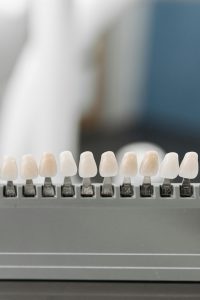Porcelain Veneers vs Composite Bonding – both are cosmetic dental procedures that are designed to improve the appearance of your teeth, but they differ in purposes, materials, and method of application. So, which is better – Porcelain Veneers or Composite Bonding?
What’s the purpose of Composite Bonding?
Composite bonding is ideal for fixing minor cosmetic issues such as small chips, cracks, gaps, or discolouration. It’s also used to reshape teeth or for more extensive dental work. This procedure is quick, minimally invasive, and a cost-effective way to enhance the appearance of teeth.
What’s the purpose of Porcelain Veneers?
Veneers are designed for more significant cosmetic transformations, addressing issues like severe discolouration, large gaps, uneven teeth, or extensive wear. They create a long-lasting, natural-looking smile and are often chosen for their ability to dramatically enhance the appearance of teeth with a durable, permanent solution.
How Is Composite Bonding Made?
Composite bonding materials include a tooth-coloured composite resin made from a blend of acrylic resin and finely ground glass particles, providing durability and a natural appearance. A bonding agent
is used to adhere the composite to the tooth, while etching gel, containing phosphoric acid, prepares the tooth surface by creating microscopic roughness for better adhesion. The resin is cured using a specialised blue or UV light and then polished with abrasive materials to achieve a smooth, natural-looking finish
How Are Veneers Made?
Veneers are made from either porcelain or composite resin, both designed to mimic the natural appearance of teeth.
Porcelain is highly durable, stain-resistant, and offers a lifelike translucency, while composite resin is more affordable but less durable.
Porcelain veneers are bonded to the tooth using a dental adhesive and require a thin layer of enamel to be removed for proper fit. Porcelain veneers are typically crafted in a dental lab, while composite resin veneers are sometimes sculpted directly onto the teeth. Both materials are polished to blend seamlessly with the surrounding teeth.
How long will Composite Bonding last?
Composite bonding typically lasts between 4–8 years with proper care. It is more prone to chipping, staining, and wear over time, especially for people who grind their teeth or frequently consume staining foods and drinks. Regular dental check-ups and good oral hygiene can help extend its lifespan.
How long do Veneers last?
Veneers, especially porcelain ones, are highly durable and can last 10–15 years or more with proper care. They are resistant to stains and less likely to chip or crack compared to composite bonding. However, they require good oral hygiene and care to prevent damage to the underlying tooth structure.
The cost: Porcelain Veneers vs Composite Bonding
How much does Composite Bonding cost?
| Composite Filling | £150 – £250 |
| Composite Edge Bonding | £250 per tooth |
How much do Veneers cost?
| Composite Veneers | £330 per tooth |
| Porcelain Veneers | £750 per tooth |
To learn more about composite bonding or veneers at Kamran Rasul – The Dental Clinic you can contact us by phone at 0151 433 9634 or email at info@kamranrasul.com. Alternatively, you can schedule an appointment or consultation directly through our website. Visit the Composite Bonding or Composite Veneers pages for further details.





